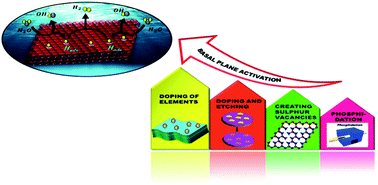A concise discussion on MoS2 basal plane activation toward the ennoblement of electrocatalytic HER output
Abstract
Over the last decades, MoS2, being a member of the transition metal dichalcogenide family, is the second most extensively studied 2D-material, followed by graphene. Owing to its distinct electronic structure and outstanding physical and chemical properties. Being a widely used semiconductor material, some directions of its applications are still limited. The semiconducting 2H-phase of MoS2 shows less catalytic activity due to the presence of a large number of chemically inert basal planes, whereas the metallic 1T-phase of MoS2, which exhibits higher catalytic activity, cannot be furnished on a large scale due to the stabilization issue. Taking these demerits into consideration, the current researchers are highly dedicated to ameliorating the catalytic performance of MoS2 by activating the chemically inert basal planes of MoS2. There occurs a generation of new catalytic active centers on the basal plane of MoS2 in addition to its active edge sites, which elevates its catalytic activity, i.e., electrocatalytic HER. In view of this, the current review sheds light on several methodologies for the activation of inert basal plane of MoS2 including doping, etching, creating sulphur vacancies, and pores, which is of great importance toward boosting the catalytic execution of MoS2.

- This article is part of the themed collection: Sustainable Energy and Fuels Recent Review Articles


 Please wait while we load your content...
Please wait while we load your content...